Ceramic slip is a fluid blend of clay and various raw components utilized in the creation of pottery and ceramics. Its versatile nature allows it to serve as a glaze, a bonding agent, or even a casting material. Primarily employed in crafting pottery and ceramic ware, ceramic slip stands out for its affordability, user-friendly characteristics, and the ready availability of its constituent materials. Delving deeper into the world of ceramic slip reveals why it has become a favored option in the realms of pottery and ceramic production.
What is ceramic slip?
Ceramic slip, a fundamental component in the realm of pottery and ceramics, is a pliable concoction comprising clay, water, and other potential ingredients. This malleable mixture serves as the raw material for crafting both utilitarian and decorative pieces, offering artisans the flexibility to shape their creations either by hand or with molds.
Once the desired form is achieved, the ceramic pieces undergo a meticulous drying process. This gradual drying is essential to eliminate excess moisture, ensuring structural integrity during subsequent stages. As the ceramics reach the leather-hard stage, artists can intervene, adding intricate details or decorations before the final transformative step – firing in a kiln. This firing process not only solidifies the structure but also imparts the characteristic durability and aesthetic appeal to the ceramics.
Ceramic slip finds widespread application in both amateur and professional ceramics production. The adaptability of porcelain and stoneware clays to be converted into slips makes them particularly suitable for casting molds and creating intricate decorative pieces. The versatility of ceramic slip lies not only in its application in traditional pottery but also in its role in diverse manufacturing industries.
One notable attribute of ceramic slip is its remarkable workability period. Thanks to the evaporative nature of air, slips remain in a pliable state for several weeks. This extended timeframe offers artists the luxury of making adjustments, experimenting with designs, or applying glazes before the final firing process. It becomes a canvas for creativity, allowing for a dynamic and iterative artistic process.
Beyond its artistic applications, Ceramic slip plays a crucial role in various manufacturing industries. Its ability to atomize particles into smaller sizes facilitates their uniform application onto surfaces. Moreover, Ceramic slip contributes to reducing particle contaminants, enhancing its significance in ensuring quality manufacturing processes.
The multifaceted nature of ceramic slip transcends its role as a mere material in pottery. From its pliable beginnings to the transformative firing process, ceramic slip embodies the synergy of art and science, offering artists and industries alike a medium that is not only versatile but also conducive to innovation and quality craftsmanship.
Unraveling the legacy of ceramic slip
Ceramic slip, a rich amalgamation of clay, water, and additional additives, holds a storied history dating back to the Neolithic age. Early humans, with intuitive creativity, employed this viscous mixture to craft not only functional pottery but also intricate sculptures and tiles. As time unfolded, ceramic slip seamlessly integrated itself into the tapestry of traditional art forms, evolving from its humble beginnings to becoming an indispensable component of artistic expression.
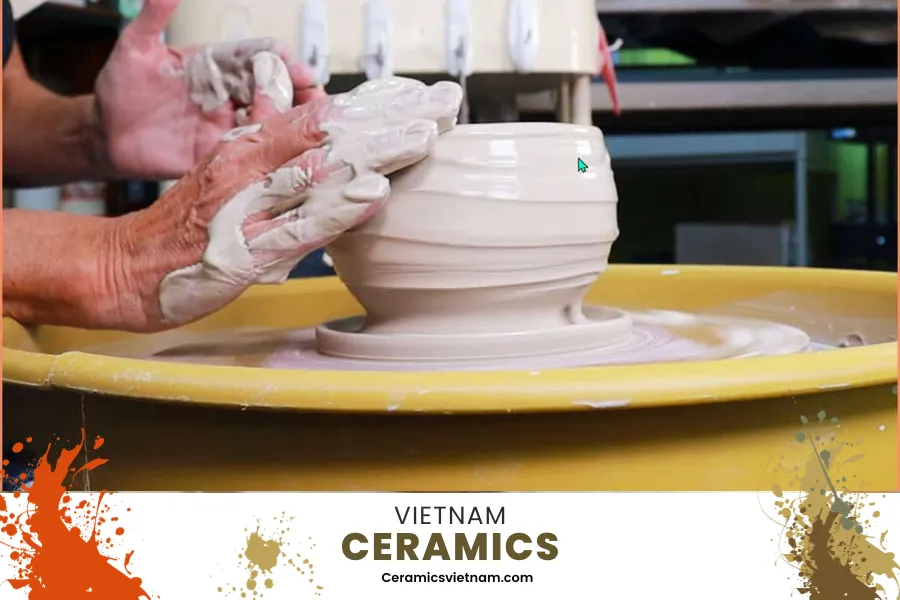
Unraveling the legacy of ceramic slip
The origins of ceramic slip
The roots of ceramic slip delve deep into the annals of ancient civilizations, where clays became the raw material of choice. Gathering and processing these clays involved intricate techniques such as filtration, sedimentation, and sun-drying. The result was a versatile and workable paste, a precursor to what we now know as ceramic slip.
Around 5000 BCE, the Sumerians pioneered the use of slips as a refined clay additive in pottery production. This marked a significant step in the evolution of ceramics. Concurrently, the knowledge of ceramic techniques traversed continents, finding its way to Asia and Europe. The development of stronger firing techniques during this era played a pivotal role in shaping the versatility of ceramic slip. In China, slips found expression in adorning figures and vessels, while Europe embraced the popularity of red slips, especially in Jugendstil ceramics.
By the year 1500 CE, glaze chemistry had undergone remarkable advancements. Sophisticated lead-free glazes, particularly in earthenware, came to the forefront. These innovative glazes, comprising ground quartz or sand mixed with a clay body colorant called slip, were transformative. Not only did they seal pottery surfaces, preventing leakage, but they also eliminated the need for firing at exceptionally high temperatures, streamlining the production process.
In North America, indigenous communities played a crucial role in shaping early slip casting practices. The ingenious use of ash and water mixtures to purify clay before its utilization in ceramics production exemplifies the resourcefulness of these native peoples. However, the paradigm shift occurred in 19th century England with the advent of ‘slipcasting.’ This breakthrough process, which gained prominence, set the stage for industry-wide standardization in slip production during the 20th century. The ramifications were significant, allowing artisans worldwide to craft utilitarian and artistic vessels with aesthetic consistency across substantial batches of pottery products.
The intricate journey of ceramic slip, from ancient civilizations to modern standardization, unfolds as a narrative of human ingenuity and craftsmanship. Exploring its detailed origins reveals not only the evolution of a material but also the cultural and artistic influences that have shaped this versatile medium over millennia.
The evolution of ceramic slip
Ceramic slip, a delicate fusion of clay and water, stands as a versatile and integral component in the intricate world of ceramic production processes. Its evolutionary journey traces back to 5000 BC, where the earliest evidence illuminates its utilization in crafting clay slabs, small figurines, and toys. As the hands of artisans shaped these early creations, the latent potential of ceramic slip began to reveal itself, finding application in larger construction endeavors, tools, and the crafting of utensils.
Throughout the annals of history, diverse cultures across the globe have harnessed the adaptability of slip in various artistic forms. From the elegance of wheel-thrown vessels to the intricate detailing of hand-built wall plaques, slip has been a canvas for creative expression. In the realm of elaborate artistry, slip transcended its basic composition by merging with other materials such as silica and organic elements. This transformative blend gave birth to sgraffito, a technique where layers of color are meticulously scraped away, unveiling an undercoat adorned with intricate designs or patterns. Interestingly, in certain regions, this artful decoration has affectionately earned the moniker “cappuccino ware,” drawing an imaginative parallel to the beloved coffee drink.
In the modern era, technological strides have mechanized the application of slip, ushering in an era of mass production. Yet, the tactile allure and nuanced control offered by handcrafting remain paramount for many artisans. Oxides enter the equation, enhancing slips with a spectrum of vibrant hues. This infusion of color finds its place in diverse applications, whether it be glazing furniture, restoring broken pottery, or sculpting smaller pieces that infuse visual vitality into various designs.
Challenges in remote locations, where supplies may be scarce, are met with resourcefulness. Numerous accessible recipes empower artists to concoct their own ceramic slip, tailoring it to specific needs and desired outcomes. This dynamic evolution of ceramic slip not only bridges the ancient and the modern but also reinforces its enduring relevance in the diverse and ever-evolving realm of artistic expression.
Varieties of ceramic slip
Ceramic slip, a fluid amalgamation of clay and inorganic chemicals, serves as the foundational liquid for crafting ceramics. Comprising a blend of clay, water, and additional elements like oxides and fluxes, ceramic slip boasts a versatile nature. Its applications extend to the creation of both greenware and bisqueware, offering a spectrum of possibilities.
Now, let’s delve into the diverse realm of ceramic slip types:
Porcelain slip
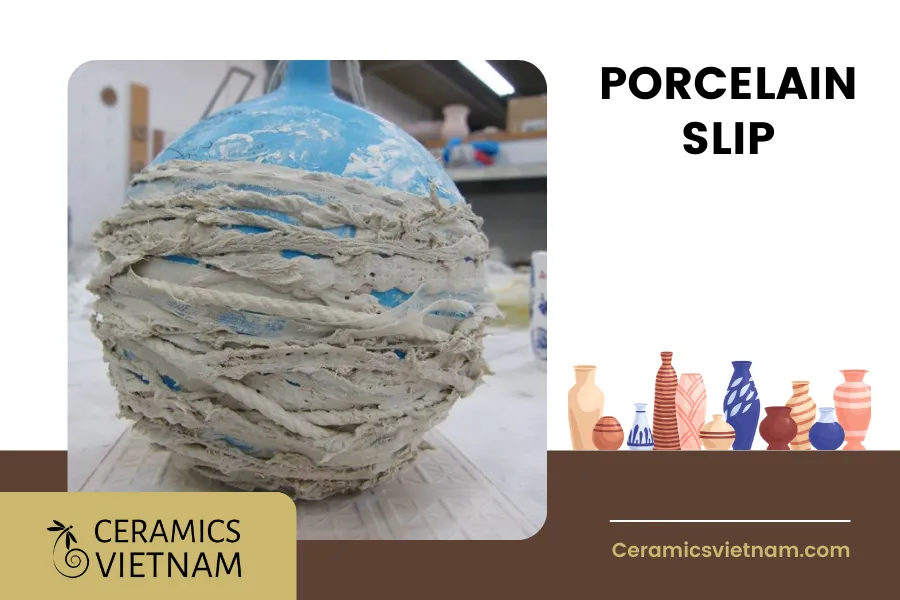
Porcelain slip
Porcelain slip, a refined variant within the realm of ceramic slips, stands as a linchpin in the production of both porcelain and earthenware ceramics. Its composition is an artful blend of refined clay, flux (typically feldspar), and water, intricately enriched with specific additives tailored to achieve desired characteristics. This meticulous concoction underscores the delicate balance required in the creation of porcelain slip.
In the alchemy of ceramics, the proportions of ingredients in porcelain slip exhibit variability, a nuanced dance that fluctuates from manufacturer to manufacturer and project to project. Bodies, the structural foundation of ceramics, typically embrace approximately 10-35% flux, while slips, the fluid canvas for artistic expression, span a range of 25-35% flux. Equally critical is the water content, a key determinant for optimal workability, with recommended levels fluctuating between 30-50%.
The plasticity of porcelain slip takes center stage in its utility. A highly plastic nature ensures that artisans can shape it effortlessly on the wheel or cast it into molds without the peril of cracking during firing—a testament to the meticulous crafting required in the ceramic artist’s studio. To enhance its thermal shock capability and minimize shrinkage during firing, specific chemical additions are introduced, adding layers of complexity to the artistry.
Firing temperatures, a pivotal aspect of the ceramic process, hinge on specific recipes but generally range from 1160°C to 1280°C (2120°F– 2350°F). This critical phase in the journey of porcelain slip contributes significantly to the material’s ultimate form and integrity. Post-glaze firing, a carefully orchestrated cooling cycle becomes imperative, fostering proper maturation and averting the risk of warping.
In essence, porcelain slip emerges as more than a medium—it becomes a carefully orchestrated symphony of ingredients, firing techniques, and cooling cycles. Through its intricate details and nuanced characteristics, porcelain slip stands as a testament to the mastery required in the timeless craft of ceramic artistry.
Stoneware slip
Stoneware slip, a distinguished member in the expansive family of ceramic slips, emerges as a cornerstone in the creation of both functional and ornamental ceramics. A sophisticated blend of clay and water, stoneware slip transcends simplicity by accommodating additional elements such as dyes, oxides, and stains. Notably, its composition deviates from earthenware slips, boasting higher proportions of kaolin or high-fire clays. This pivotal difference allows stoneware pieces to withstand higher firing temperatures, ultimately achieving vitrification—a testament to the nuanced craftsmanship involved.
The versatility of stoneware slip extends beyond its composition to the intricacies of its viscosity. Striking a delicate equilibrium is imperative, necessitating sufficient water content for seamless integration with the clay, yet avoiding excessive thinness to ensure controlled application through pouring or brushing. This precision in viscosity underscores the meticulous nature of crafting with stoneware slip.
To cater to the diverse needs of artisans, slip producers craft a spectrum of stoneware slips, available in both raw and bisque fire versions. Beyond the standard repertoire, specialized decorative styles, including sgraffito slips and crackle slips, cater to the demands of advanced ceramic applications, opening avenues for artistic exploration.
The infusion of alumina into the base mix introduces a layer of complexity, elevating the strength of stoneware slips while mitigating shrinking during firing—a critical enhancement for applications, particularly in intricate tile work. Stains, a versatile addition, bring forth a palette of color variations to stoneware, transforming through the high-temperature firing process and contributing to the distinctive aesthetics of the final piece.
An essential note in the artisan’s handbook emphasizes the strategic incorporation of oxygenated compounds, such as stains, during the mixing phase. This deliberate integration into the liquid form of slips or glazes circumvents the risk of burning up during firing when applied to already dry clay surfaces. It underscores the meticulous planning required in the ceramic artist’s studio.
In the expansive realm of ceramics, stoneware slip transcends its role as a mere medium. It emerges as a dynamic collaborator, offering a canvas for artistic expression while demanding precision, expertise, and an intimate understanding of its intricacies from the hands that mold and shape it.
Earthenware slip
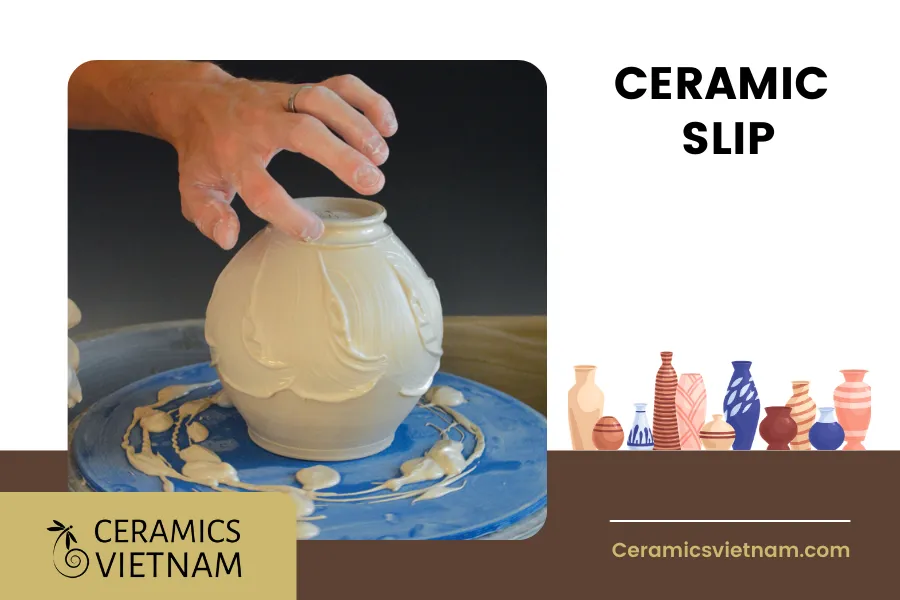
Earthenware slip
Earthenware slip, revered as the cornerstone of ceramic craftsmanship, unfolds a rich tapestry of tradition and versatility. Formed by the intricate blend of clay particles and water, this timeless medium attains a creamy texture, setting the stage for a myriad of artistic expressions. Notably, earthenware slip embraces firing at lower temperatures, typically within the range of 1000-1200°C (1832-2192°F), distinguishing it in the vast landscape of ceramic slips.
The applications of earthenware slip span a diverse spectrum, showcasing its adaptability to various artistic endeavors:
- Tiles: Providing a canvas for intricate designs, patterns, and vibrant colors, earthenware tiles become both functional and artistic elements in architecture and interior design.
- Tableware: Serving as the foundation for crafting functional and aesthetically pleasing dishes, earthenware slip contributes to the creation of bowls, plates, and other culinary essentials with a touch of artistic flair.
- Sculpture: Allowing artists to mold and shape their imaginative creations, earthenware slip becomes the very substance through which sculptures come to life, capturing the essence of artistic vision.
- Electric insulators: Beyond the realm of art, earthenware slip finds utility in electrical applications, serving as insulators that facilitate the seamless flow of electricity.
The allure of earthenware slip extends beyond its functional applications. Artists often infuse this versatile medium with a palette of colors before firing, resulting in captivating decorative pieces. The vibrant hues, once melded with the earthy tones of the clay, create a visual symphony that adds a unique and personalized touch to the world of ceramics.
In the hands of skilled artisans, earthenware slip becomes a vessel not only for tradition but also for innovation. Its inherent adaptability and transformative qualities offer boundless possibilities, making it a medium that continues to shape both practical and artistic masterpieces in the ever-evolving landscape of ceramic artistry.
Applications of ceramic slip
Ceramic slip, a fluid amalgamation of clay, water, and diverse materials, stands as a dynamic medium with a multitude of applications. Primarily utilized in the creation of ceramic products, such as tiles, plates, and sculptures, ceramic slip unveils a world of possibilities. Its versatility extends beyond mere construction, often serving as a coating or glaze on pottery, adding layers of aesthetic appeal.
In the exploration that follows, we’ll unravel the diverse ways in which ceramic slip proves its worth and the advantages it brings to the realm of ceramic craftsmanship. Let’s delve into the intricate landscape of this liquid clay and the myriad roles it plays in shaping functional and artistic creations.
Slip casting
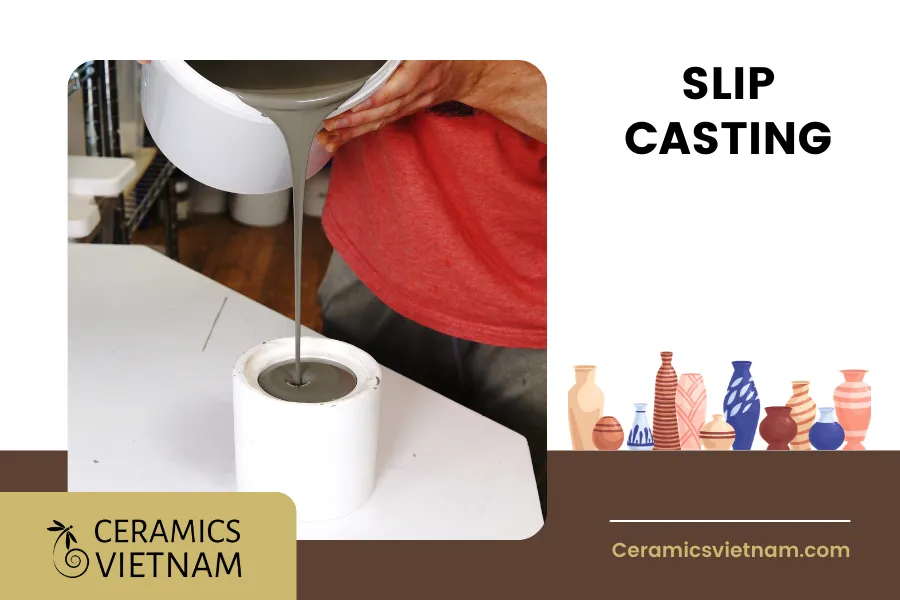
Slip casting
Slip casting stands as a pinnacle application of ceramic slip, offering a method where the fluidity of liquid clay, known as slip, converges with the precision of plaster molds to create uniformly shaped masterpieces. This intricate process unfolds with precision and care: a measured volume of liquid clay is poured onto a plaster mold, left to settle momentarily, and then excess slip is carefully poured out. The magic happens as the plaster absorbs water from the slip, orchestrating the creation of an even wall thickness that faithfully mirrors the contours of the mold.
As the cast creation undergoes a designated drying period—adjusted based on its thickness—it is delicately extracted from the mold. Subsequently, a meticulous curing process ensues, ensuring the thorough removal of every hint of moisture. This multi-stage method culminates in the emergence of meticulously crafted clay forms, each bearing the unique textures and intricacies of the original mold.
Within the intricate realm of ceramic craftsmanship, slip casting is not merely a technique; it is an art form that demands attention to detail and a keen understanding of the materials involved. The result is a series of repeatable and accurate clay forms, each distinguished by the distinct textures imbued during the slip casting process. This method, with its blend of science and artistry, stands as a testament to the precision achievable in the hands of skilled artisans.
Glazing
Ceramic slip, a liquid clay endowed with a luxurious creamy consistency, transcends its utilitarian origins and ascends to the realm of artistic expression in the enhancement of pottery. A versatile medium, renowned in the ceramic industry, it unfolds in an array of colors and textures, inviting a myriad of creative possibilities. Yet, its true prowess comes to the forefront in the meticulous art of glazing—a transformative process that turns ordinary pieces into extraordinary works of art.
In the intricate world of ceramic glazing, ceramic slip takes on a pivotal role, dictating the journey of pottery enhancement. The narrative commences with the bisque firing of the pottery, where the application of heat amalgamates clay particles, rendering the piece porous. In this vulnerable state, any liquid applied to the surface engages intimately with the composition. To fortify and protect the piece, an impermeable layer known as glaze becomes indispensable. This strategic application serves as a shield, preventing liquids from infiltrating the piece and disrupting its color or shape.
Opting for ceramic slip as a glaze unveils a cascade of advantages, distinguishing it from alternative glazing methods. Its creamy consistency and ample working time make it an effortless application process, standing in contrast to the complexities of chemical-based or dust glazes. The resulting colors are more vibrant than those achieved with dust glazes, offering an appealing visual depth. Economically, slip glazes present a cost-effective alternative to many chemical-based counterparts. When sprayed onto surfaces, they ensure uniform coverage, creating a seamless finish.
Moreover, the use of ceramic slip as a glaze empowers artists with enhanced control over intricate detailing for decorative purposes. The process unfolds with minimal cleanup, adding a layer of convenience to the artistic endeavor. In essence, ceramic slip doesn’t merely coat pottery; it becomes an alchemical agent, turning every piece into a canvas for vibrant expression and meticulous detailing. This convergence of form and function marks the brilliance of ceramic slip in the art of glazing.
Decorating
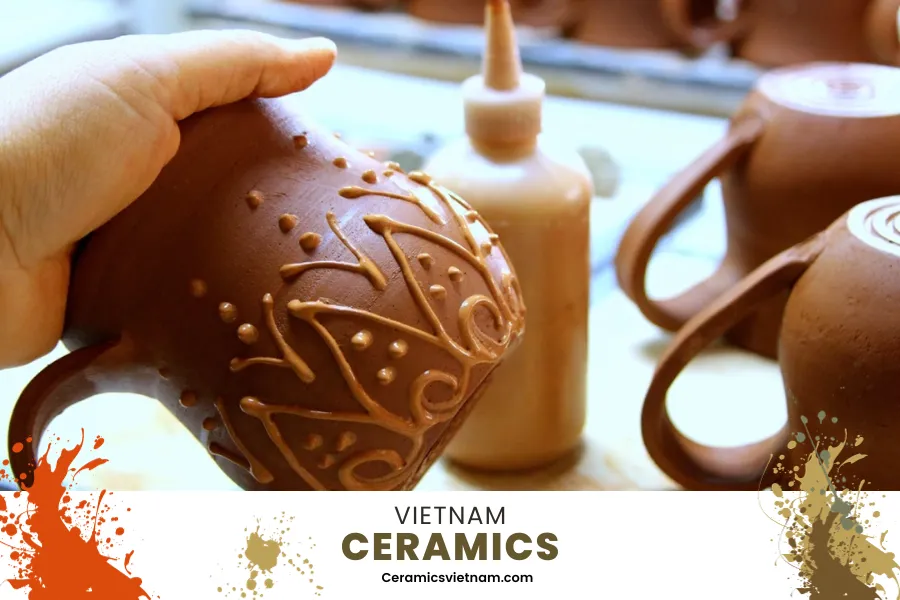
The journey of using ceramic slip for decoration is an art form that demands careful preparation
In the realm of ceramic decoration, ceramic slip stands as a revered choice among potters and ceramicists, offering a versatile medium to bring creative visions to life. This liquid clay mixture, primarily comprised of clay and water, serves as a pliable substance that can be manipulated into desired forms. Its application onto ceramics is a nuanced art, achieved either by pouring it onto the ceramic surface or delicately painting it on with a brush. The result? Intricate patterns, captivating textures, and vibrant colors that breathe life into the ceramic canvas.
However, the journey of using ceramic slip for decoration is an art form that demands careful preparation. The surfaces must be primed to ensure proper adherence of the slip. The preparation process varies depending on the type of surface, with resilient greenware (unfired clay pieces) benefiting from pre-cleaning before slip application, while more delicate earthenware pieces require prior glaze firing. Cleanliness is paramount; any dirt particles on the artifacts can disrupt the firing process and affect the final outcome.
Once the surface is meticulously prepared, a myriad of techniques comes into play. Brushwork, printing, stamping – these are the tools wielded by artisans to breathe imaginative life onto the ceramic piece. Consistency in slip application across several firings, with brief intervals of 10-15 minutes between each, ensures optimal coverage of all colors embedded in the design. As the final touch, after successful firings and allowing the piece to set overnight for shrinkage and hardening, the masterpiece is ready for admiration.
In the delicate dance of artistry and craftsmanship, the use of ceramic slip for ceramics decoration becomes a testament to the meticulous process that transforms raw materials into vibrant, textured, and visually arresting masterpieces.
In essence, ceramic slip stands as a liquid clay, its composition woven from diverse materials such as clay, talc, and silica. This fluid medium transcends the conventional, offering a canvas for artists to craft a diverse array of artworks, from intricate small figurines to expansive earthenware dinnerware. The crafting and manipulation of ceramic slips prove to be more accessible and flexible compared to traditional pottery-making methods, amplifying the artistic possibilities. The palette of colors available in this form of art is both broad and expansive.
A notable feature of ceramic slip lies in its seamless integration with glaze, introducing an additional layer of intricacy to the design while preserving the tone and essence of the underlying material. The fusion of ceramic slip with glaze manifests in detailed and captivating pieces, each a testament to the marriage of art and craftsmanship. These creations, enriched by the combination of slip and glaze, are not fleeting; they stand as enduring symbols of artistic expression, promising to captivate and endure for many years to come.
Read more














Leave a reply